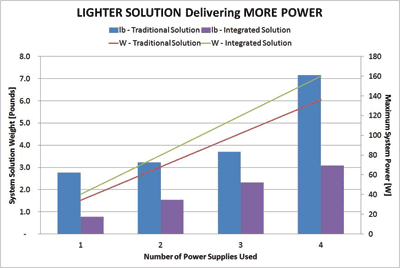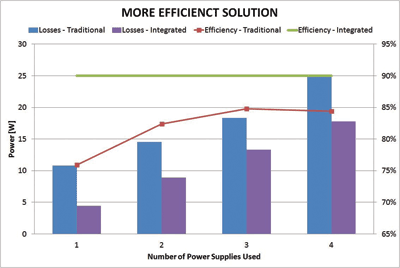What designers must consider when selecting a driver, focusing on why eliminating the step-down transformer is a good idea
BY IRENE SIGNORINO
Director of Business Development
Industrial and Automotive
Microsemi
www.microsemi.com
In Canada and the United States, power is often distributed to outdoor lighting fixtures at 347 or 480 Vac, respectively. With the adoption of LEDs, the light fixture must then convert the power to much lower voltages on the output; in the U.S. this voltage needs to be below 60 Vdc if safety extra-low-voltage (SELV) constraints are observed.
Until now, this conversion was accomplished using bulky and inefficient step-down transformers that increased design complexity as well as power losses in the conversion stage. What is needed is a new type of integrated power supply that can provide this conversion without the need of the external step-down transformer thus simplifying the design, reducing the driver system weight and eliminating the energy losses associated with the transformer.
According to industry analyst firm Strategies Unlimited, the U.S. market has taken the lead in proving the viability of LED technology for outdoor lighting applications. The Department of Energy (DOE), the Municipal Solid-State Street Lighting Consortium, and the Design Lights Consortium have all undertaken efforts to increase the industry awareness of the quality requirements necessary to successfully progress the LED adoption. Strategies Unlimited says the CAGR for unit growth is forecasted to grow 26% from 2010 to 2015, with the market reaching $544 billion in revenues in 2015.
The driver system is the key to enabling the promise of the LEDs. LEDs are complex, sophisticated semiconductor devices whose tightly interdependent photometric (luminous flux and efficacy), electrical (current, voltage, power) and thermal (junction temperature) characteristics often behave in a highly nonlinear manner. LED drivers play a critical role in ensuring the light fixture’s efficiency, life expectancy and compliance with current regulations. Beyond providing an efficient and controlled power conversion optimized to drive the LEDs, the system can also integrate dimming capabilities, protections, and other features that decrease the operating costs even further and enhance the value to the end user.
A new class of integrated drivers is now able to specifically address and eliminate the challenge of using an external step-down lighting transformer in many outdoor and high-bay LED lighting fixtures. This article will explore the choices a street light fixture designer must consider when selecting a driver and specifically focus on why eliminating the external step-down transformer might be a good idea.
Power conversion function
In the past, an accepted driver solution for a 480- or 357-Vac street lighting system was to use a step-down lighting transformer to convert the 480- (or 347-) Vac) input voltage to the lower voltage required by the power supply driving the LED (often 277 or 120 Vac). One or more power supplies can be used with one step-down transformer to then drive the LED output strings — often at voltages below 60 Vdc.
Today, a valid alternative is to choose an integrated power supply that can handle the 480-Vac-to-less-than-60-Vdc conversion in one, single product.
To understand the choice, it is important to comprehend the key characteristics of each component involved in the driver system. A typical 125-VA-rated lighting transformer can weigh 2.3 pounds and dissipate up to 7 W. A reference 40-W power supply able to handle input voltages of 120 or 277 Vac can weigh less than a half pound and be 90% efficient. A new, integrated 480 Vac input 40 W power supply is still 90% efficient and weighs only slightly more (0.80 lbs) than the previous one.
When envisioning a modular design of the driver system, a designer can choose to scale the driver system by using multiple power supplies. Typically, no more than four power supplies would be used as the complexity added into the wiring system would decrease the benefits of the scalable design.
Figure 1 shows the difference in weight between the driver system of fixtures built using traditional solutions and those built using next-generation integrated LED drivers that eliminate bulky external step-down transformers. As shown, a significant (>50%) driver system weight reduction can be achieved, thus enabling some transportation costs reductions as well as more compact designs.

Fig. 1: The latest LED driver technology reduces weight while delivering more power.
Because the external step-down transformer is completely eliminated and the power conversion is achieved with a power supply at least as efficient as the original power supply, the new driver solution also provides increased energy savings to the street light operator (see Fig. 2 ). For example, a typical installation of 10,000 40-W fixtures used by a municipality that pays $0.1 kWh can achieve a five-year period energy savings of $400,000.

Fig. 2: Integrated LED driver solutions deliver increased energy savings.
Finally, removing the external component increases the reliability of the LED driver by reducing the points of potential failure.
Additional driver features
Today’s LED drivers integrate many features that are specifically optimized for streetlights. These features are as critical for a successful lighting fixture design as the decision of using (or not using) an external step-down transformer.
Dimming capabilities and integrated protections (over current, over voltage and/or thermal protections) are fairly well understood and properly used.
Additional benefits can be realized by leveraging the integrated fault detection capabilities of the next-generation LED drivers. Fault detection and management capabilities can be used to detect and communicate a faulty condition. The managing entity is often required to provide a certain amount of light in places used by the public. If an accident happens due to lack of light, the entity might be exposed to potential liability claims. A system that provides a quick alert about a faulty light is therefore valuable. Such a system can be as simple as a person noticing and reporting the non operating light or as complex as a wired or wireless data network actively detecting and reporting the faulty light immediately and around the clock. If the light is part of a network, a device capable of detecting and reporting the fault to the network is necessary. The newer drivers do in fact integrate such capability. Figure 3 shows a wiring diagram for incorporating fault management functionality into an integrated LED driver solution.

Fig. 3: Fault management circuitry for integrated LED driver solution.
The same integrated capability can also be used for basic troubleshooting, such as the light fixture not turning on (if the fault alert is on, but there is no light, then it is likely the LED module is damaged but not the driver).
One of the first examples of this new generation of integrated LED drivers is Microsemi’s LXMG221D-0700040-D2F solution, which integrates a high-voltage step-down transformer into a single compact, lightweight and high-performance solution. The device operates on 347- or 480-Vac systems for North American and Canadian installations, and is designed for constant-current, single 700-mA string applications using approximately 12 to 17 LEDs (
The device features high active power factor correction and low total harmonic distortion across the entire input voltage range at full load, and is dimmable to 10% by different dimming methods (0 to 10 V, PWM or potentiometer) for additional power savings. Multiple protection features include overvoltage and overcurrent protection and automatic over-temperature shutdown. Built-in fault management also enables fixtures to sense and manage failed (short and open) LED situations.
Municipalities face increasing pressure to deliver improved street lighting reliability while reducing costs and simplifying fixture monitoring and maintenance. Achieving these goals has been difficult with traditional solutions that require cumbersome transformers with high power losses or with poorly designed drivers.
Now, thanks to the availability of integrated LED drivers that provide the power conversion without needing a external bulky transformer, fixture designers can create significantly smaller, lighter, and more efficient solutions. These drivers also deliver more benefits and higher value to the end user via highly reliable designs, dimming, fault detection and management capabilities, and built in robust protections. ■
Advertisement
Learn more about Microsemi





